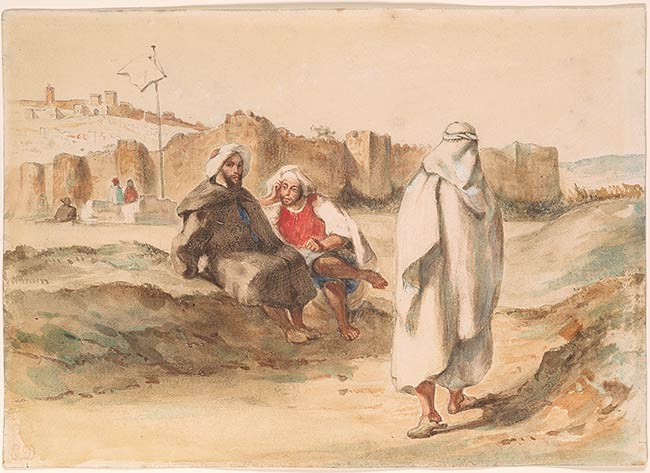

Delacroix's trip to North Africa in 1832 yielded drawings and copious notes, inspiring work for years after his return. The artist executed this watercolor several years after he returned. He used a desert palette, pale and monochromatic, and not the saturated jewel tones of his earlier watercolors. The viewer is outside the coastal city of Tangier on a path skirting its ruined walls behind a man in a white burnoose and babouche slippers who walks past two seated men, one of whom directs his gaze at us. The scene is quiet, quotidian.
Delacroix used this watercolor in the early 1850s as the basis for a painting (1852-53; Minneapolis Institute of Arts). The observed nature of the watercolor has been rethought as a pictorial narrative. The landscape is less barren and dusty, and the robed figure has been replaced by a colorfully costumed woman seen frontally, looking over her right shoulder as she passes the two seated men. Identified by scholars as a woman in Jewish costume, the painting introduces a new tension and ambiguity of relationships that is missing from the watercolor. Delacroix was pleased with his later evocations of such scenes: the elapse of decades allowed him to forget details and circumstances and work with “memory and nostalgia” to create new compositions.
Andrieu, Pierre, 1821-1892, former owner.
Brame, Hector, former owner.
Thaw, Eugene Victor, former owner.
Thaw, Clare, former owner.
The Morgan Library & Museum, New York, NY, "Drawn to Greatness: Master Drawings from the Thaw Collection", 2017. Exh. cat., no. 98, repr.
Stampfle, Felice, and Cara D. Denison. Drawings from the Collection of Mr. and Mrs. Eugene V. Thaw. New York : Pierpont Morgan Library, 1975, no. 82 (also in Thaw III, no. 71)
Denison, Cara D. et al. The Thaw Collection : Master Drawings and New Acquisitions. New York : Pierpont Morgan Library, 1994, no. 71.
